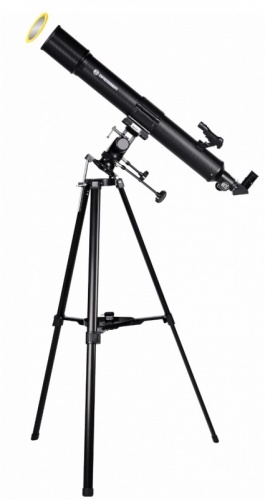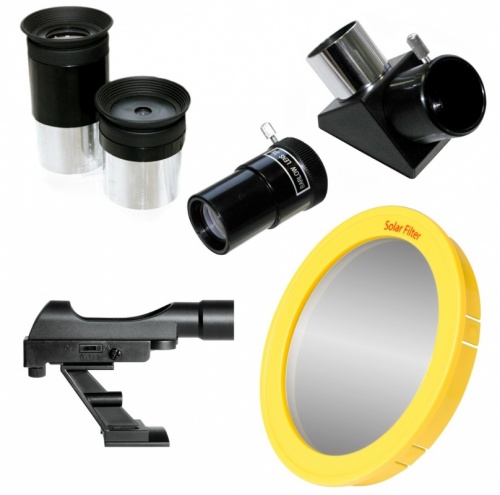Off to the stars - the entry-level telescope with lots of accessories, versatile MPM mount with fine adjustment in both axes, solar filter & smartphone adapter
Complete set of telescope, tripod, mount and accessories
Easy-to-use refracting telescope for beginners
Versatile MPM mount, azimuthal & equatorial
Fine adjustment with flexible shafts in 2 axes
Telescope aperture: 90 mm / focal length: 900 mm
For Sun, Moon, planets and many deep sky objects
Astrophotos possible with smartphone
Plenty of accessories to get started straight away
With secure lens solar filter
Set up, look through, be amazed: with the BRESSER Taurus 90/900 MPM lens telescope, beginners can let their admiring gaze wander quickly and easily across the night sky. The complete astronomy set comes with everything you need for fascinating observations of the stars, planets, Sun and Moon: an astronomical lens telescope with 90 mm aperture and 900 mm focal length, an azimuthal and equatorial MPM mount, a tripod and a wide range of accessories for your new astro-hobby. The highlight of the mount: with the fine adjustment in both axes, the careful alignment and tracking of the telescope is super easy.
A classic for astro-newbies - the telescope
Very easy to handle, even for beginners and children: this classic refracting telescope - a so-called Fraunhofer achromatic refractor - will help you get started in astronomy successfully. Thanks to the modern, precisely coated optics, you will benefit from good imaging properties when looking at astronomical sights. With its 90 mm aperture, this beginner’s telescope already collects around 165 times more light than the human eye and thus offers good resolving power. In addition, the 90 mm aperture and 900 mm focal length result in a large focal ratio (aperture/focal length) of 1 to 10 (F/10). The effect: you will enjoy a sharp image with good contrast.
Due to the combination of large aperture and long focal length the telescope for beginners is a flexible multi-talent. It’s not only very suitable for observing the Moon, Sun and planets. You can also use it to get a closer look at many deep-sky objects. Enjoy the view of sparkling open star clusters and globular clusters, but also gas nebulae such as the Orion Nebula M42 or the Dumbbell Nebula M27 can be seen beautifully.
But what about the magnification? The resolving power achieved by the 90 mm aperture easily allows magnifications of up to about 180x with really sharp images. Technically, the beginner’s telescope can do a lot more: with the included accessories, magnifications of up to 675x are possible. However, you want to see the celestial bodies as clearly as possible, but as the magnification increases, the image sharpness can slowly decrease. How much you can magnify during your astronomical explorations also depends on more than just your telescope. The air turbulence in the atmosphere (seeing conditions) is also always an important factor.
Twice as good for flexible sky observation - mount and tripod
The height-adjustable aluminium tripod with a particularly adaptable mount provides a secure footing for your explorations of the universe. The MPM (Multi-Purpose-Mount) can be used both azimuthally and equatorially. In the azimuthal mode, its handling is particularly intuitive: just as with a common photo tripod, you can simply swing the beginner’s telescope to the left and right, up and down by hand. Alternatively, you can use the two flexible shafts with fine adjustment to point and track your telescope with extra precision and comfort.
The integrated polar-wedge also allows you to tilt the axis cross into an equatorial position. This means that one axis is parallel to the Earth's axis. You then only have to compensate for the movement of the celestial bodies on this one axis. No more simultaneous movement along the two axes! Of course, the two flexible shafts with fine adjustment are also usable for the equatorial mode. A handy feature of the tripod: a storage plate is placed between the tripod legs. Here your astronomy accessories are always within reach.
Fully equipped for your amazing astronomy adventure - the accessories
In addition to the telescope, tripod and mount, you need a few extras in order to make your very own exciting discoveries in the sky. Therefore, the telescope set for beginners contains all the necessary equipment and more. An important helper: the LED viewfinder. Using it is very easy: install the direction finder, which projects a red dot onto a small ground-glass screen, parallel to the actual beginner's telescope. When you look through it, the red dot appears to float in front of the sky. This allows you to quickly see what your telescope is pointing at. Thus, the LED viewfinder enables you to easily find celestial objects and align the telescope precisely - before going on to the detailed view through the magnification of the telescope.
You decide how big you want the astronomical objects to appear by choosing the eyepiece. Even through the two eyepieces included in the astronomy set (4 mm and 20 mm) you will be able to get very different images of the celestial bodies. Would you like to see even more details? Then simply triple the magnification of the eyepiece using the 3x Barlow lens. And should you wish for even more flexibility by means of different magnifications, you will have a large selection of optional eyepieces for your beginner’s telescope. The 31.7mm (1.25 inch) socket diameter corresponds to an international and manufacturer-independent standard.
You don't want to have to lie down underneath the beginner’s telescope for your observations, even though it’s pointed vertically into the sky? You won’t have to, because the 90-degree star diagonal mirror always allows you to look in comfortably. This is also true during the day. For not only the night holds fascinating sights in store for us. That's why you can safely observe the star of our daytime sky with the solar filter: the Sun. So enjoy marvelling at fascinating granulation and sunspots.
CAUTION: Never point the telescope at the Sun without the solar filter!
Anyone who makes impressive observations naturally wants to capture and share them. That's why you can easily use the smartphone adapter to take fascinating snapshots of the Moon, the Sun and other amazing objects with your mobile phone camera. Perfect as a first step into the exciting world of astrophotography!
FEATURES
Beginner’s telescope with 90 mm aperture and 900 mm focal length
Achromatic refractor type Fraunhofer
For observing the Sun, Moon, planets, star clusters and gas nebulae
Height-adjustable tripod
Azimuthally and equatorially usable MPM mount
Precise tracking through flexible shafts and fine adjustment in both axes
Easy to use, good for beginners
Focal ratio F/10, thus sharp image and high contrast
Two eyepieces and one Barlow lens with 31.7 mm (1.25 inch) sockets for different magnifications
Safe solar observation with the included solar filter
Entry into astrophotography with smartphone camera adapter
SCOPE OF DELIVERY
Starter lens telescope
Aluminium tripod
MPM mount
Eyepieces: 4 mm and 20 mm (1.25 inch socket)
Barlow lens 3x (1.25 inch socket)
Star diagonal mirror
LED illuminated dot finder
Solar filter
Smartphone camera adapter
Accessory tray
Astronomy software download
Instruction manual





















 Fast & Reliable Delivery
Fast & Reliable Delivery Helpful & Friendly Staff
Helpful & Friendly Staff Best Prices Online
Best Prices Online 100% Secure Shopping
100% Secure Shopping